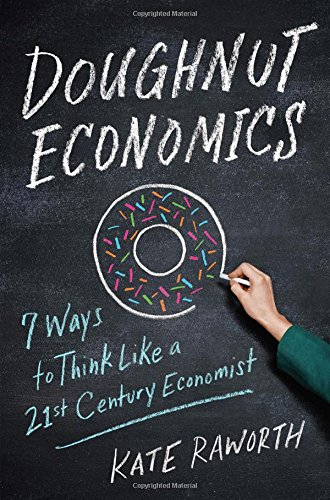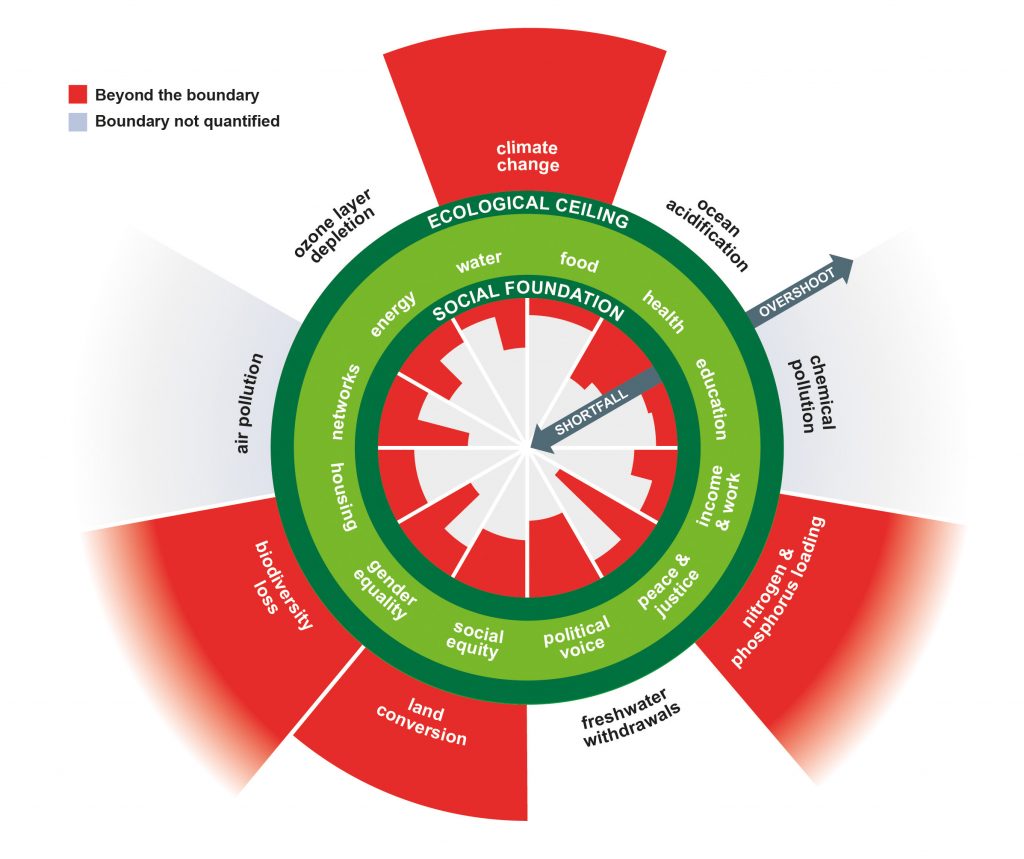
This is about a new way of thinking about economics.
The traditional economic model is just a model of an economy floating in empty space. The Doughnut economic model recognizes that the economy exists within the earth’s boundaries and is reliant on life and the resources that the planet provides.
If we exceed what the planet can sustainably provide and adsorb eventually we crash the whole system. As she says we take and use (sometimes we use just once) and throw it away. “There is no away”. Generations in the future are going to look back on us and ask did we know? Previous generations did not know and therefore could not have drawn a model like this but we know.
Kate Raworth describes her idea in the short video below.
Below is the structure of Doughnut Economics.

The outer rim of the doughnut symbolizes the outer edge of what we can take from our planet and return sustainably. The red fields illustrate by how much we are exceeding the earth’s ability to support us.
The inside of the doughnut is about fairness. It is about human needs for food, water, and other goods as well as education, equity, and political voice. The inner ring symbolizes the minimum boundary below which we should not let other humans fall. The red in these areas illustrates how much we are failing on this.
Doughnut Economics 7 ways to think like a 21 century economist:
1. Change the goal (it is not continual GDP growth)
2. See the big picture
3. Nuture Human Nature
4. Get savvy with systems
5. design to distribute
6. create to regenerate
7. Be agnostic about growth
This is about discarding the old very limiting economic reality that has been taught to so many students and is running so many of our governments, and imagining a new one with a new picture.
As Lisa Feldman Barrett said in her book 71/2 lessons about the brain, our ability to imagine different realities and believe in them so they become the new reality is our “super power”. “Superpowers work best when we know we have them”.
If we start to think of our economy as a doughnut and we know we are creating the economy then we are all economists and changing our reality based on our beliefs and actions.
About 1 hour in to the video above, Raworth talks about companies. She says she is not particularly interested in product packaging, or how the ingredients are sourced, or how the employees are paid, though that is important. She is interested in the company design. “How the company is designed matters. This will determine if the company is regenerative or not.” This is more of a systems thinking approach. In systems thinking the thing we get is shaped by the process we use to get there. In this thinking we should focus on setting up the system (company) properly instead of the details. This will make it more likely we achieve and even exceed our expectations.
5 design traits of a company:
1. A living Purpose bigger than themselves
2. The network your company lives in. What are the values of the network? Does it reinforce or pull from the purpose?
3. Governance Who is in the room when decisions are made?
4. How is the company owned? By a family, a VC capital group, financially motivated shareholders, or shareholders who love who you are, and share your purpose.
5. How is the company financed? Is finance in service to the purpose? By people or institutions who are committed to the same purpose and a fair return? Or just a maximum return?
Obviously there are a lot of similarities with Conscious Capitalism. A higher purpose, shareholders who care about and support the purpose, and a stakeholder view which includes the planetary ecosystem as even more than a stakeholder. In this model it is the ecosystem in which the economy lives and is dependent on.
Cities (Amsterdam and Brussels) and even some countries are beginning to play with the doughnut economic model. In a complex system a solution can not be put in place through central control. It needs to evolve through experimentation. It happens by variation, selection, and replication of the things that work. (Recognizing that what works in some cases may not work in others.) We can learn from each other.
For this reason they have set up this Doughnut Economics ACTION Lab for people to communicate what they are trying and how it is working.
Cheers for Friday,
Gavin Watson, Chair, Conscious Capitalism Connecticut Chapter

Latest Posts
